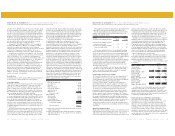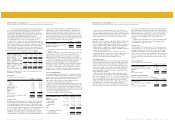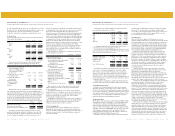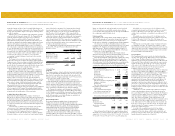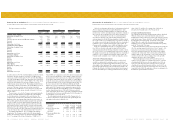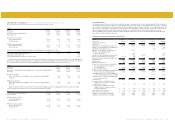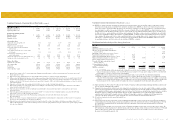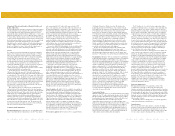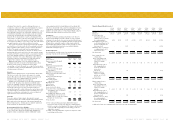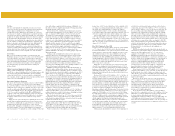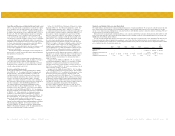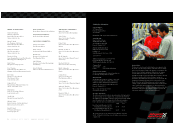Advance Auto Parts 2001 Annual Report Download - page 24
Download and view the complete annual report
Please find page 24 of the 2001 Advance Auto Parts annual report below. You can navigate through the pages in the report by either clicking on the pages listed below, or by using the keyword search tool below to find specific information within the annual report.
42 ADVANCE AUTO PARTS ANNUAL REPORT 2001 ADVANCE AUTO PARTS ANNUAL REPORT 2001 43
Management’s Discussion and Analysis of Financial Condition and
Results of Operations
The following discussion and analysis of financial condition and results of
operations should be read in conjunction with “Selected Financial Data,”
our consolidated historical financial statements and the notes to those
statements that appear elsewhere in this report. Our fiscal year ends on the
Saturday nearest December 31 of each year. Our first quarter consists of
16 weeks, and the other three quarters consist of 12 weeks. Our discussion
contains forward-looking statements based upon current expectations that
involve risks and uncertainties, such as our plans, objectives, expectations
and intentions. Actual results and the timing of events could differ
materially from those anticipated in these forward-looking statements as a
result of a number of factors, including those set forth under the “Risk
Factors” and “Business” sections of our recently filed annual report on
Form 10-K with the Securities and Exchange Commission.
General
We conduct all of our operations through our wholly owned subsidiary,
Advance Stores Company, Incorporated and its subsidiaries, or Advance
Stores. We were formed in 1929 and operated as a retailer of general
merchandise until the 1980s. In the 1980s, we sharpened our marketing
focus to target sales of automotive parts and accessories to “do-it-
yourself,” or DIY, customers and accelerated our growth strategy. From
the 1980s through the present, we have grown significantly through new
store openings, strong comparable store sales growth and strategic
acquisitions. Additionally, in 1996, we began to aggressively expand our
sales to “do-it-for-me,” or DIFM, customers by implementing a
commercial delivery program that supplies parts and accessories to third
party professional installers and repair providers.
At December 29, 2001, we had 1,775 stores operating under the
“Advance Auto Parts” trade name, in 37 states in the Northeastern,
Southeastern and Midwestern regions of the United States and 669 stores
operating under the “Discount Auto Parts” trade name in the Southeastern
region of the United States. In addition, we had 40 stores operating under
the “Western Auto” trade name primarily located in Puerto Rico and the
Virgin Islands. We are the second largest specialty retailer of automotive
parts, accessories and maintenance items to DIY customers in the United
States, based on store count and sales. We currently are the largest
specialty retailer of automotive products in the majority of the states in
which we operate, based on store count.
Our combined operations are conducted in two operating segments,
retail and wholesale. The retail segment consists of our retail operations
operating under the trade names “Advance Auto Parts” and “Discount Auto
Parts” in the United States and “Western Auto” in Puerto Rico, the Virgin
Islands and one store in California. Our wholesale segment includes a
wholesale distribution network which includes distribution services of
automotive parts and accessories to approximately 470 independently
owned dealer stores in 44 states operating under the “Western Auto” trade
name. Our wholesale operations accounted for approximately 3.9% of our
net sales for the year ended December 29, 2001. The discussion for all
periods presented in this section has been restated to reflect our Western
Auto store located in California in the retail segment.
Acquisitions and Recapitalization
Discount Acquisition. On November 28, 2001, we acquired Discount in a
transaction in which Discount’s shareholders received $7.50 per share in
cash (or approximately $128.5 million in the aggregate) plus 0.2577
shares of our common stock for each share of Discount common stock.
We issued approximately 4.3 million shares of our common stock to the
former Discount shareholders, which represented 13.2% of our total
shares outstanding immediately following the acquisition. The acquisition
has been accounted for under the purchase method of accounting.
Accordingly, the results of operations for Discount for the periods from
December 2, 2001 are included in the accompanying consolidated
financial statements. The purchase price has been allocated to assets
acquired and liabilities assumed based on their respective fair values.
Negative goodwill of $75.7 million, resulting from total excess fair value
over the purchase price, was allocated proportionately as a reduction to
non-current assets, primarily property and equipment.
In connection with the Discount acquisition, we issued an additional $200
million face value of 10.25% senior subordinated notes and entered into a
new senior credit facility that provides for (1) a $180 million tranche A term
loan facility and a $305 million tranche B term loan facility and (2) a $160
million revolving credit facility (including a letter of credit sub-facility).
Upon the closing of the Discount acquisition, we used $485 million of
borrowings under the new senior credit facility and net proceeds of $185.6
million from the sale of the senior subordinated notes to, among other things,
pay the cash portion of the acquisition consideration, repay all amounts
outstanding under our then-existing credit facility, repay $204.7 million of
outstanding indebtedness of Discount, including prepayment penalties, and
purchase Discount’s Gallman distribution facility from the lessor.
At November 28, 2001, Discount had 671 stores in six states,
including the leading market position in Florida, with 437 stores.
Including the acquired Discount stores, we had 2,484 stores at December
29, 2001. On a pro forma basis, our net sales and EBITDA, as adjusted,
for 2001 would have been $3.1 billion and $261.9 million. We expect to
achieve ongoing purchasing savings as a result of the acquisition. In
addition, we expect to achieve significant savings from the optimization of
our combined distribution network, including more efficient capacity
utilization at Discount’s Mississippi distribution center, as well as from the
reduction of overlapping administrative functions. During 2002, we expect
these savings to result in approximately $30 million of incremental
EBITDA, excluding certain one-time integration expenses. We expect
these one-time integration expenses to total approximately $53 million
from the close of the acquisition through the end of 2003, approximately
$41 million of which we expect to incur in 2002.
Carport Acquisition. On April 23, 2001, we completed our acquisition of
the assets used in the operation of Carport Auto Parts, Inc. retail auto parts
stores located throughout Alabama and Mississippi. Based upon store
count, this made us the largest retailer of automotive parts in this market.
Upon the closing of the acquisition, we decided to close 21 Carport stores
not expected to meet long-term profitability objectives. The remaining 30
Carport locations were converted to the Advance Auto Parts store format
within six weeks of the acquisition. The acquisition has been accounted for
under the purchase method of accounting. Accordingly, the results of
operations of Carport for the periods from April 23, 2001 are included in
the accompanying consolidated financial statements. The purchase price of
$21.5 million has been allocated to the assets acquired and the liabilities
assumed, based on their fair values at the date of acquisition. This
allocation resulted in the recognition of $3.7 million in goodwill.
Western Auto Acquisition. On November 2, 1998, we acquired Western
Auto Supply Company, or Western, from Sears. The purchase price
included the payment of 11,474,606 shares of our common stock and
$185.0 million in cash. Certain of our stockholders invested an additional
$70.0 million in equity to fund a portion of the cash portion of the
purchase price, the remainder of which was funded through additional
borrowings under our prior credit facility, and cash on hand. The Western
merger was accounted for under the purchase method of accounting.
Accordingly, the results of operations of Western for the periods from
November 2, 1998 are included in the accompanying consolidated
financial statements. The purchase price has been allocated to assets
acquired and liabilities assumed based on their respective fair values.
Negative goodwill of $4.7 million, resulting from total excess fair value
over the purchase price, was allocated proportionately as a reduction to
non-current assets, primarily property and equipment.
We have achieved significant benefits from the combination with
Western through improved purchasing efficiencies from vendors,
consolidated advertising, distribution and corporate support efficiencies.
The Western merger resulted in the addition of a net 545 Advance Auto
Parts stores, 39 Western Auto stores and the wholesale distribution network.
Recapitalization. On April 15, 1998, we consummated a recapitalization
in which Freeman Spogli & Co. and Ripplewood Partners, L.P. purchased
approximately $80.5 million and $20.0 million of our common stock,
respectively, representing approximately 64% and 16% of our outstanding
common stock immediately following the recapitalization. In connection
with the recapitalization, management purchased approximately $8.0
million, or approximately 6%, of our outstanding common stock. The
purchase of common stock by management resulted in stockholder
subscription receivables. The notes are full recourse and provide for
annual interest payments, at the prime rate, with the entire principal
amount due on April 15, 2003. In addition, on April 15, 1998, we entered
into our prior credit facility and also issued $200 million of senior
subordinated notes and approximately $112 million in face amount of
senior discount debentures. In connection with these transactions, we
extinguished a substantial portion of our existing notes payable and long-
term debt. These transactions collectively represent the “recapitalization.”
We have accounted for the recapitalization for financial reporting
purposes as the sale of common stock, the issuance of debt, the
redemption of common and preferred stock and the repayment of notes
payable and long-term debt. In connection with the Discount acquisition,
we repaid all amounts outstanding under our prior credit facility and
entered into our senior credit facility.
Non-recurring Charges
During the fourth quarter of 2001, we recorded the following non-recurring
charges, net of tax: $0.7 million in integration expenses associated with the
Discount acquisition; $2.2 million in lease termination expenses resulting
from the planned closure of approximately 27 Advance Auto Parts stores
that overlap with Discount stores; $5.2 million in stock option
compensation charges described below; $6.3 million in supply chain
initiatives described below; $6.5 million to reduce the book value of certain
excess property currently held for sale described below; $2.1 million to
implement an accounting change associated with the reclassification of
cooperative income from selling, general and administrative expense to
gross margin described below; and $3.7 million in charges related to the
write-off of deferred debt issuance costs associated with refinancing our
credit facility in connection with the Discount acquisition.
The $5.2 million, net of tax, in stock option compensation charges
resulted from variable provisions of our employee stock option plans that
were in place when we were a private company, and that we since have
eliminated. Under the modified plan, option exercise prices are fixed and
therefore will not result in future compensation expense. No additional
common shares or options were issued as a result of these modifications.
The $6.3 million, net of tax, in expenses relating to supply change
initiatives is related to our recent review of our supply chain and logistics
operations, including our distribution costs and inventory stocking levels.
As part of this review, we have identified a portion of our inventory and
expect to identify additional inventory that we may offer in the future only
in certain store locations or regions. The expenses related to this initiative
are primarily related to restocking and inventory handling charges. We
may generate significant cash proceeds as a result of this initiative by
reducing our inventory investment while continuing to maintain high
levels of customer service and in-stock positions.
The reduction of book value of certain properties of $6.5 million, net
of tax, is related to the revaluation of certain excess properties currently
held for sale. In addition, we have closed and may explore the future
possibility of closing additional distribution facilities and may write-down
the value of such facilities in connection with our supply chain initiative.
The expense of $2.1 million, net of tax, to implement an accounting
change results from a change in our method of accounting for certain
cooperative advertising funds received from vendors. Previously, we
accounted for these funds as a reduction to advertising expense as the
related advertising expenses were incurred. In order to better align the
reporting of these payments with the sale of the associated product, we
decided to recognize these payments as a reduction to the cost of
inventory acquired from vendors, which results in a lower cost of sales for
the products sold. We believe this is a preferable method of accounting.
The change will result in a slightly more conservative recognition of
income in future periods. This change in accounting principle has been
applied in our 2001 financial statements as if the change occurred at the
beginning of our 2001 fiscal year, and has been recognized as a
cumulative effect of the change in accounting principle. This change
results in lower cost of sales with corresponding increases in selling,
general and administrative expenses.
Critical Accounting Policies
Our financial statements have been prepared in accordance with
accounting policies generally accepted in the United States. Our
discussion and analysis of the financial condition and results of operations
are based on these financial statements. The preparation of these financial
statements requires the application of these accounting policies in addition
to certain estimates and judgments by our management. Our estimates and
judgments are based on currently available information, historical results
and other assumptions we believe are reasonable. Actual results could
differ from these estimates.
The following critical accounting policies are used in the preparation
of the financial statements as discussed above.
Vendor Incentives
We receive incentives from vendors related to cooperative advertising
allowances, volume rebates and other miscellaneous agreements. Many of
the incentives are under long-term agreements (terms in excess of one
year), while others are negotiated on an annual basis. Our vendors require
us to use certain cooperative advertising allowances exclusively for



